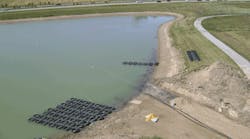Latest from Geothermal
Sponsored
Michigan’s largest geothermal system cuts HVAC costs by 35%
SAGINAW, MICH. — Saginaw Valley State University (SVSU) here is home to the largest closed-loop geothermal pond system in the state of Michigan. Built into a 6.75 acre, 2.2-million gal. retention pond with an average depth of 13-ft., the geothermal system will heat and cool the university’s Crystal M. Lange Health and Human Services building, scheduled to be completed this summer, and is expected to cut total building energy costs by approximately 35% per year — an estimated $63,000 per year in energy savings.
The geothermal pond system will not only heat and cool the new building, it will also be connected to an adjoining building, plus have the ability to heat and cool future campus buildings. SVSU has an existing addition 7 acre south pond and is estimated to have 700 tons of additional capacity for future heat pump expansion, and two additional glycol lines have been installed for future building projects.
“The geothermal system is installed interconnecting to the adjoining Regional Educational Center building’s pipes, so on lighter loads the geothermal can serve both systems with better energy efficiencies without firing the boilers and chillers in the Regional Educational Center,” said Wayne Kerbelis, mechanical engineer and principal of Peter Basso Associates Inc., Troy, Mich., the project’s consulting engineering firm.
“The SVSU Health Science Building is cooling dominant; the design provided the heat transfer coils in the pond to meet both Michigan's heating and cooling requirements,” added Kerbelis.
The north pond gains heat from solar radiation, convection from air (when air is warmer than the water) and ground conduction. In the summer, the pond loop system uses the body of water as the heat sink, thus, heat escapes the pond water through surface evaporation. When the pond surface is frozen, in winter, heat transfer is dominated by contact between the loops and the water and the soil surface at the bottom of the pond.
“In utilizing this technology no fossil fuels are used at the site for heating or cooling the building, thus reducing the SVSU campus carbon footprint,” said Kerbelis. “Overall building energy savings over a conventional system are projected at 35%, 50% in heating energy alone. The payback on the added investment is less than five years.”
Pond heat exchangers will transfer tempered water in a closed-loop piping system to provide transfer of energy to the Health Science Building's five 70-ton Clima-Cool water-to-water heat pumps.
The geothermal pond system consists of 28 heat exchanger grids, each with 14 coils which produces 378 tons of cooling and high density polyethene distribution piping (approximately 120,000-ft.). The pond heat exchanger system will utilize separate piping grids, each provided with multiple coils per grid. The system was installed by floating heat exchangers on the surface of the pond in their approximate locations. Then approximately 10,000 gallons of DOWFROST Heat Transfer Fluid was pumped into the heat exchanger system, causing the grids and coils to sink to the bottom of the pond.
According to Kerbelis, the pond’s circulating water pumps by Bell & Gossett use variable speed motor drives and very the flow of water to the water-to-water heat pumps to save electrical energy during variable heating or cooling modes.
“The pond water is actually a condenser water system, which either rejects heat to the pond in the summer or provides heat for the building when the heat pumps units are on the reverse cycle,” said Kerbelis. “The pond water loop system is on a variable flow and can range from 300 GPM to 1,200 GPM based on heating and cooling demands of the building.”
The geothermal pond system and new Health Science Building will be controlled through direct digital controls provided by Johnson Controls Inc.
A superior system
The mechanical room in the Health Sciences Building houses the five water-to-water heat pumps, which are connected together. One end of the heat pump system provides chilled water for cooling and the other end provides hot water heating. The heat pumps are reverse cycling where the first through fifth heat pump can either heat or cool. Heated water or chilled water from the heat pumps is supplied to two Innovent central variable volume air energy recovery handling units and the hydronicunder floor heating system provides supplied comfort control.
The water-to-water heat pump units utilize scroll compressors and a reverse refrigerant cycle, providing either chilled water or hot water for the building heating and cooling systems.
SVSU’s Health and Human Service building will use the central heat pump output of hot water and chilled water to provide under floor heating, air side heating and cooling, building entryway snowmelt and domestic water heating.
According to Kerbelis, maintenance is far superior with this type of system and is greatly reduced by dealing with five heat pumps located in a mechanical room versus 70 to 100 individual water-to-air heat pumps spread throughout the building.
The underground supply and return piping system enters an underground concrete vault that houses the piping manifolds, distributing separate 2-in. supply and return piping to each grid located in the pond. Piping manifolds balance flow to each grid, plus accommodates flushing and cleaning of each grid system separately without shutting down the complete system.
Contractors from Michigan, including mechanical contractors S&J Heating and Insulation, Dewitt, Mich., and Remer Plumbing and Heating Inc., Saginaw, Mich., installed the geothermal system.
According to Jerry Shooltz, owner of S& J Heating & Insulation, it took four men and approximately 2,800 man hours to complete the project.
“Geothermal life cycle operating costs will save the university 40% over the conventional system,” said Shooltz. “Current geothermal installations save more than 14 million barrels of crude oil per year. Geothermal is a full-time, renewable energy source, burns no fossil fuel, is 400% efficient, is environmentally friendly, and of course, it [the project] created more jobs for the state of Michigan.
Once completed, SVSU plans to have the Health and Human Services building, which will house the departments of nursing, kinesiology, occupational therapy, health sciences and social work, certified Silver by the U.S. Green Building Council LEED program.
Besides the geothermal pond system, other sustainable technologies will be utilized in the building, such as solar panels and water-efficient products that will conserve water bymore than 30%, according to Brian Keeler, LEED AP,of Spence Brothers, the projects construction manager, Saginaw, Mich.
Candace Roulo
Candace Roulo, senior editor of CONTRACTOR and graduate of Michigan State University’s College of Communication Arts & Sciences, has 15 years of industry experience in the media and construction industries. She covers a variety of mechanical contracting topics, from sustainable construction practices and policy issues affecting contractors to continuing education for industry professionals and the best business practices that contractors can implement to run successful businesses.


